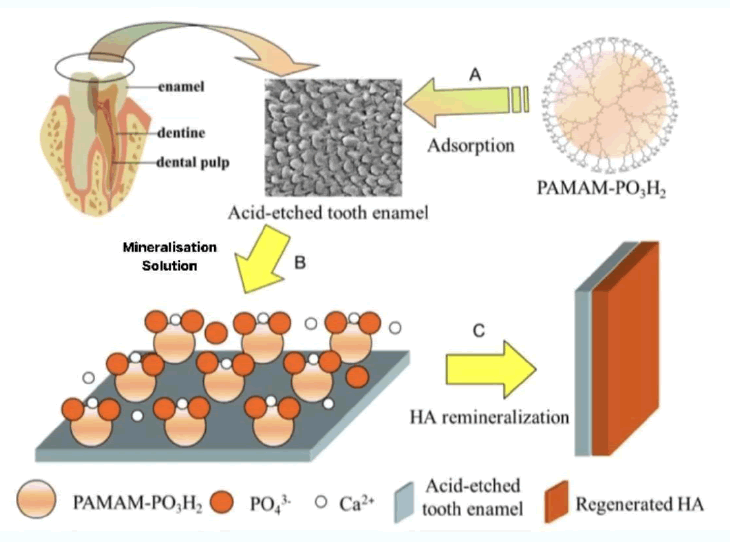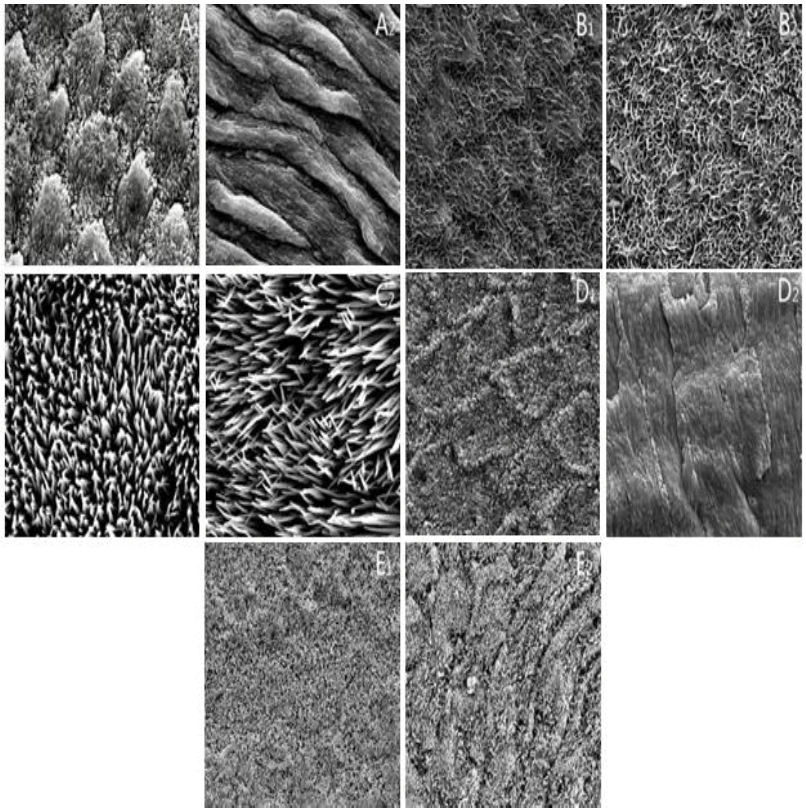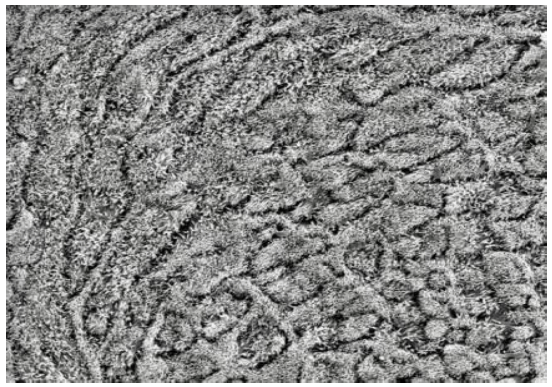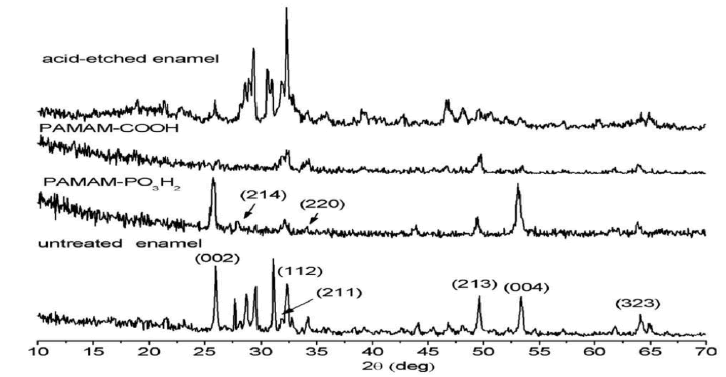Review - International Journal of Medical Research & Health Sciences ( 2023) Volume 12, Issue 2
Regeneration of Biomimetic Hydroxyapatite on Acid Etched Human Enamel using PAMAM Template in Vitro
Rahul Pandhare*, Saurabh Sabnis, Rahul Kunkulol, Deepak Vikhe, Gajanan Pandhare and Lehya Mounica KadaliRahul Pandhare, Rural Dental College, Pravara Institute of Medical Science, Maharashtra, India, Email: rahulpandhare33@gmail.com, pandharegr@gmail.com
Received: 01-Feb-2023, Manuscript No. ijmrhs-23-88404; Editor assigned: 02-Feb-2023, Pre QC No. ijmrhs-23-88404(PQ); Reviewed: 09-Feb-2023, QC No. ijmrhs-23-88404(Q); Revised: 15-Feb-2023, Manuscript No. ijmrhs-23-88404(R); Published: 28-Feb-2023
Abstract
Introduction: Traditional dental restorative materials do not fit well with the natural tissue at the lesion interface because their components, structure, and properties are not similar to those of the natural hydroxyapatite. Objective: To mimic the natural biomineralization process regulated by amelogenin in developing enamel using a PAMAM template. This work will explain the nature of PAMAM-PO3H2 with acid-etched enamel in a mineralization solution. Methodology: Here, we attempted to use a phosphate-terminated PAMAM dendrimer and investigate its application as an amelogenin analog on the remineralization process of acid-etched enamel. The fourth generation PAMAM-PO3H2 was arranged. For the mineralization solution, a 3 ml calcification solution containing 2.58 mM CaCl2 and 1.55 mM KH2PO4, 20 mM HEPES, and 180 mM NaCl was arranged. NaOH will be used to adjust the pH of the mineralization solution and fluoride will be obtained from NaF. Tooth samples with intact enamel were obtained. The roots were separated from the teeth and the enamel samples were cut longitudinally to obtain 3x3x1 mm samples. These samples were coated with PAMAM-P03H2 and reacted with the mineralization solution. Conclusion: This will help us understand the biomineralization process in enamel formation. The application of PAMAM with phosphate and mineralization solution could result in the formation of biomimetic hydroxyapatite.
Keywords
Hydroxyapatite enamel regeneration polyamidoamine
Introduction
Human enamel is the hardest mineralized tissue in the human body [1, 2]. It comprises 96% inorganic material and 4% organic material. The inorganic material is nanorod-like hydroxyapatite crystals arranged into highly organized hierarchical microstructures. It has been revealed that amelogenin secreted by ameloblasts is the major enamel protein, and constitutes approximately 90% of all organic matrix material in developing enamel [3, 4]. It plays an important role in the biomineralization process of tooth enamel, especially for the crystallites to form the wellorganized prism pattern. However, these proteins that induce and control the crystallization of apatite are almost completely degraded or removed during enamel maturation [5, 6]. Therefore, mature enamel cannot reform highly organized crystals.
Traditional dental restorative materials include metals, compound resins, and ceramics. However, these do not fit well with the natural tissue at the lesion interface because their components, structure, and properties are not similar to those of the natural hydroxyapatite [7, 8]. These substitute materials are quite different from normal enamel and require the sacrifice of healthy tooth tissue. Thus, the materials are not ideal for repairing defective enamel.
Natural amelogenin and its supramolecular assembly have been directly applied and have achieved effective regeneration of the hydroxyapatite layers [9, 10]. Other systems, such as self-assembled anionic peptide, peptide amphiphiles, a glycerin-enriched gelatin gel containing phosphate and fluoride ions, and a combination of glutamic acid and nano apatite particles, have all been reported to mimic and biomineralization process and regenerate enamel-like hydroxyapatite. However, since it is difficult to extract/purify/store the natural protein, or there is overuse of fluoride ions and complicated multistep strategies, their further use in clinical application is limited. Thus, it is necessary to develop a simple strategy to mimic the functions of amelogenin to induce the remineralization of the surface of defective tooth enamel [11-13].
Literature Review
Protein-mineral binding is likely to play a central role in the biomineralization process by modulating both mineral nucleation and crystal growth. Currently, the biomimetic synthesis of enamel-like Hydroxyapatite (HAP) has attracted much interest from research fellows. Many procedures have been used in vitro to form enamel-like crystals, including amelogenin, calcium phosphate solution and nano-hydroxyapatite. Some have used amelogenin to mimic the biomineralization process of enamel. 11–18 Still, the structure of amelogenin and mechanisms of amelogenin-mediated mineralization has not yet been fully elucidated. Moreover, amelogenin is quite difficult to extract and store, qualities that make it relatively unsuitable for further clinical use.
Poly (Amido Amine) (PAMAM) dendrimers are highly branched polymers. Unlike conventional linear polymers, they are characterized by the presence of internal cavities, a large number of reactive end groups, and well-defined size and shape. These structures allow it to be used as biomimetic macromolecules for proteins. The synthesis of PAMAM dendrimers included a two-step interactive sequence to produce amine-terminated structures. Iterative sequencing involved alkylation with Methyl Acrylate (MA) followed by amidation with excess 1,2-ethylenediamine (EDA). The alkylation step produced ester-terminated intermediates that were referred to as ‘‘half- generations’’. The second step involved the amidation of the ester-terminated intermediates with a large excess of EDA to produce amine-terminated intermediates, which are referred to as ‘‘full-generations’’. G3.0 PAMAM dendrimers were synthesized for further phosphate modification.
Add About Hydroxyapatite and the Need for Enamel Regeneration from Abstract Aims and Objectives
The primary objective is to mimic the natural biomineralization process regulated by amelogenin in developing enamel using a PAMAM template in vitro. This work will explain to us the nature of PAMAM-PO3H2 with acidetched enamel in mineralization solution and the feasibility of the process for in situ experiments.
Based on previous studies, the present study aimed to investigate the effect of G3.0 PAMAM dendrimers with phosphate (PAMAM-PO3H2) on crystal growth on etched enamel at 370C and pH 7.0. The morphology and mineral phase of the regrown crystal is analyzed by Scanning Electron Microscopy (SEM) and a possible mechanism is explored explaining how the enamel-like structures are formed. The hypothesis is that the PAMAM dendrimers could act as an organic template to control the growth of crystals on the enamel surface.
Materials
PAMAM with a surface functional group PO3H2 was made available from a tertiary private manufacturer. The phosphate group has a stronger affinity for calcium ions than the carboxyl group and it can also provide strong HAbinding capability. Human tooth enamel samples were extracted at the Department of Oral and Maxillo-facial Surgery of tertiary Dental College. Standard procedures for extraction were followed during the extraction. Most of the other reagents and solvents were made available from the Department of Biochemistry of tertiary Dental College.
Methods
Sound human third molars were obtained from the Department of Oral and Maxillo-facial Surgery of tertiary Dental College. The organic contaminants on the teeth were removed by a scalpel blade after extraction. Teeth were soaked with 3% sodium hypochlorite to remove adhered bacteria and rinsed with PBS. The roots were separated from the teeth and the enamel samples were cut longitudinally with a diamond saw to obtain three samples of 3 mm, 3 mm, and 1 mm. A water-cooled carborundum disk was then used to polish the determined surface of the samples, while the other surfaces were wrapped in acrylic resin. The samples were stored in 0.5% thymol solution at 4°C before use. The tooth enamel samples were acid-etched to produce damaged models.
A 10,000-ppm PAMAM solution was prepared and statically placed for 18 hour to ensure the self-assembly process was completed. The PAMAM coating was obtained by immersing the etched enamel samples in the PAMAM solution. After 30 min, the enamel samples were removed from the solution, rinsed with running deionized water for 50 s, and air-dried. These samples were then reacted with a mineralization solution and after air-drying were sent for investigation (Figure 1).
The tooth enamel samples were coated with PAMAM-PO3H2 and dried naturally. Next, the samples were dried with a nitrogen stream at room temperature for the 20s. The samples were immersed in 3 mL of calcification solution containing 2.58 mM CaCl2 and 1.55 mM KH2PO4 at 37Ë?C, buffered by 20 mM HEPES and 180 mM NaCl. The concentration of the mineralization solution was referred from previous studies, in which amelogenin was used as the template to form the biomimetic HAP on the etched enamel. The pH of the mineralization solution was adjusted to 7.00 using 1 M NaOH. NaF was added to obtain 1 mg/L fluoride, immediately before immersing tooth samples. The mineralization solution was sealed air-tight in a 5 mL microcentrifuge tube and incubated at 370C statically for 20 h. After the desired time, the tooth samples were removed from the solution, rinsed with running deionized water for 50 s, and air-dried.
Results
The SEM results of the longitudinal and transversal enamel surfaces showed that, after the etching, peripheral regions of enamel prisms were more demineralized than central regions, so the outline of the prisms became more distinct. After soaking in the calcium phosphate solution, irregularly arranged flake-like crystals with a thickness of 2 mm formed on the enamel surface (Figure 2).
Figure 2. SEM images of the enamel surface after acidic etching A) SEM images of crystals grown on acid-etched enamel for 20 h at 37Ë?C in HEPES-buffered calcium phosphate solution without the PAMAM-PO3H2 template and fluoride B) with1 ppm sodium fluoride C) with the PAMAM-PO3H2 template D) and with both 1 ppm sodium fluoride and the PAMAM-PO3H2 template E) (Group 1 for transversal surface and Group 2 for longitudinal surface)
There were large gaps between the flakes. With 1 ppm NaF in the remineralization solutions, the morphology of the crystals changed to a needle-like morphology with lengths of 1 mm-2 mm. When PAMAM-PO3H2 has used the gaps between enamel prisms were restored by rod-like crystals on the transversal section, and the new crystals preferred to grow in the peripheral regions than in the central regions of enamel prisms. On the longitudinal section, short rodlike crystals were formed on the enamel surface, interprismatic gaps disappeared, and the direction of the new crystals was parallel to the long axis of the enamel crystals (Figure 3).
XRD showed the type and orientation of the newly formed crystals on the tooth enamel. As shown below the (211), (002), (112), (213), (004), and (323) diffraction peaks are qualities of Hydroxyapatite and appear on the untreated enamel as expected. After acid etching, many characteristic peaks of the original tooth enamel disappear; that is, acid etching may weaken some characteristic peaks, such as (002). However, after reaction with the mineralization solution the typical (002) and (004) peaks are 458 strengthened in the PAMAM-PO3H2 treated group, while the (112), (213), and (323) peaks remain weak. In other words, more crystalline HA is newly generated on the PAMAM-PO3H2-treated sample (Figure 4).
Discussions
PAMAM-PO3H2 can be bound to single crystals from enamel through the interaction between anionic branches of the dendrimers and cationic calcium on the crystal surface. The interaction between proteins and hydroxyapatite indicates that acidic proteins are preferentially adsorbed on the crystal face along the c-axis because the crystal face is more positively charged than other faces. In this study, due to demineralization, peripheral regions of enamel prisms were suggested to be more exposed areas along with the c axis than at central regions, which can absorb more PAMAM self-assemblies to increase nucleation and growth of new crystals around enamel prisms. So, Figure 1 shows the processes of crystals surrounding the prisms on the transversal surface. This finding also explains why the phenomenon was more obvious in the SEM of the longitudinal section.
In recent studies, many methods in vitro have been used to mimic the biomineralization of human enamel, including amelogenin, calcium phosphate solution and nano-hydroxy-apatite. These results show the successful formation of enamel-like crystals. However, the experimental conditions are too harsh for clinics, and the retained crystals are perpendicular to the enamel surface without consideration of the direction of the original enamel prisms. The original crystals are very important because we believe that the principle of caries treatment, which require complete removal of infected enamel, must also be suitable for the future application of enamel biomineralization in clinics. Cavities surrounded by healthy enamel with prisms of different directions must be prepared, and if the regrown enamel layers are perpendicular to the cavity walls particularly the axial walls the microstructure of the final repaired enamel will be different from the original enamel. In the present study, we demonstrated that with the effect of the PAMAM-COOH template, the biomimetic crystals can be formed in a relatively short time and under nearclinical conditions, and the direction of the regrown crystals can be consistent with the enamel prisms on both longitudinal and transversal surfaces.
Conclusion
In this work, PAMAM-PO3H2 dendrimer mimics the natural biomineralization process regulated by amelogenin in developing tooth enamel. There is a strong binding strength between PAMAM- PO3H2 and the tooth enamel, and it cannot be easily washed off. The newly generated HA crystals induced by PAMAM- PO3H2 are highly ordered. The structure of the remineralized crystals is very similar to that of natural tooth enamel.
The good performance of PAMAM-PO3H2 is due to its phosphate group, which has a stronger affinity for calcium ions than the carboxyl group and can provide strong HA-binding capability at the same time. Thus, PAMAM-PO3H2 has shown the potential of acting as an amelogenin analog to modulate the remineralization process on human tooth enamel than PAMAM-COOH.
In conclusion, we proposed that PAMAM self-assemblies play as an organic template between the regrown crystals and etched enamel regulating both mineral nucleation and crystal growth. First, the chain-like PAMAM selfassemblies were adsorbed on the surface of the enamel crystals by electrostatic interaction between phosphate terminates and enamel crystals. When in the calcium phosphate solution, the template served as a nucleation site due to calcium binding on the carboxylic acid terminals. The interaction led to a high local concentration of calcium ions, and the deposition of HAP occurred when the phosphate ions arrived. As the deposition continued, HAP crystals started growing at specific sites along the long axis of enamel crystals and finally formed a rod-like morphology, parallel to the enamel prisms.
Summary
Human enamel regeneration is necessary to develop for replacing traditional dental restorative materials. These traditional restorative materials do not fit well with the natural tissue at the lesion interface because their components, structures, and properties are not similar to those of natural hydroxyapatite. PAMAM template can be used to mimic the natural biomineralization process in vitro. This work has also explained to us the feasibility of the process for in situ experiments. Here, as inspired by the structure and properties of amelogenin, we attempt to use phosphate-terminated PAMAM dendrimer and investigate its application as an amelogenin analog on the remineralization process of acid-etched human tooth enamel. The study was done on 10 samples that were sent for investigations under SEM- Scanning Electron Microscope and XRD- X-ray diffraction in a tertiary institute of technology. This work was carried out in the Department of Oral Pathology and Microbiology of the tertiary dental college. The study was approved by Institutional Ethics Committee. In conclusion, we proposed that PAMAM selfassemblies play as an organic template between the regrown crystals and etched enamel regulating both mineral nucleation and crystal growth. The chain-like PAMAM self-assemblies were adsorbed on the surface of the enamel crystals by electrostatic interaction between phosphate terminates and enamel crystals. The deposition continued, and HAP crystals started growing at specific sites along the long axis of enamel crystals and finally formed a rodlike morphology, parallel to the enamel prisms.
Declarations
Conflict of Interest
The authors declared no potential conflicts of interest with respect to the research, authorship, and/or publication of this article.
References
- Palmer, Liam C., et al. "Biomimetic systems for hydroxyapatite mineralization inspired by bone and enamel." Chemical Reviews, Vol. 108, No. 11, 2008, pp. 4754-83.
Google Scholar Crossref - Simmer, J. P., and A. G. Fincham. "Molecular mechanisms of dental enamel formation." Critical Reviews in Oral Biology & Medicine, Vol. 6, No. 2, 1995, pp. 84-108.
Google Scholar Crossref - Fincham, AG1, J. Moradian-Oldak, and J. P. Simmer. "The structural biology of the developing dental enamel matrix." Journal of structural biology, Vol. 126, No. 3, 1999, pp. 270-99.
Google Scholar Crossref - Chen, H. F. T. Z., et al. "Acellular synthesis of a human enamel‐like microstructure." Advanced Materials, Vol. 18, Vol. 14, 2006, pp. 1846-51.
Google Scholar Crossref - Ye, L., et al. "Amelogenins in human developing and mature dental pulp." Journal of dental research, Vol. 85, No. 9, 2006, pp. 814-18.
Google Scholar Crossref - Zhu, Li, et al. "Altered self-assembly and apatite binding of amelogenin induced by N-terminal proline mutation." archives of oral biology, Vol. 56, No. 4, 2011, pp. 331-36.
Google Scholar Crossref - Yamagishi, Kazue, et al. "A synthetic enamel for rapid tooth repair." Nature, Vol. 433, No. 7028, 2005, pp. 819-19.
Google Scholar - Dong, Zhihong, et al. "In vitro remineralization of acid-etched human enamel with Ca3SiO5." Applied surface science, Vol. 256, No. 8, 2010, pp. 2388-91.
Google Scholar Crossref - Lijima, M., et al. "Elongated growth of octacalcium phosphate crystals in recombinant amelogenin gels under controlled ionic flow." Journal of dental research, Vol. 81, No. 1, 2002, pp. 69-73.
Google Scholar Crossref - Fan, Yuwei, et al. "Amelogenin-assisted ex vivo remineralization of human enamel: Effects of supersaturation degree and fluoride concentration." Acta biomaterialia, Vol. 7, No. 5, 2011, pp. 2293-302.
Google Scholar Crossref - Kirkham, J., et al. "Self-assembling peptide scaffolds promote enamel remineralization." Journal of dental research, Vol. 86, No. 5, 2007, pp. 426-30.
Google Scholar Crossref - Huang, Zhan, et al. "Biological synthesis of tooth enamel instructed by an artificial matrix." Biomaterials, Vol. 31, No. 35, 2010. pp. 9202-11.
Google Scholar Crossref - Busch, Susanne. "Regeneration of human tooth enamel." Angewandte Chemie International Edition, Vol. 43, No. 11, 2004, pp. 1428-31.
Google Scholar Crossref




